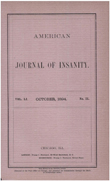Prevalence of panic in patients referred for pulmonary function testing at a major medical center
Abstract
OBJECTIVE: The authors examined the prevalence and correlates of panic disorder in a group of patients who were referred for pulmonary function testing. METHOD: Patients (N = 115) were screened for the presence of panic attacks and panic disorder with a self-report questionnaire; a subgroup (N = 25) received structured diagnostic assessment. RESULTS: Of the 115 patients, 41% (N = 47) reported panic attacks and 17% (N = 20) met screening criteria for panic disorder. From the confirmed rate of panic disorder among the subgroup who received structured diagnostic assessment, the overall prevalence rate of panic disorder was estimated to be 11% and included six of the nine patients (67%) who had a diagnosis of chronic obstructive pulmonary disease. There were no significant differences between patients with and without panic in the severity of pulmonary function abnormalities or in the response to bronchodilators. However, patients with panic attacks were significantly more likely to report dyspnea at rest and irritable bowel symptoms and tended to report difficulty swallowing. CONCLUSIONS: This study suggests that panic disorder and subsyndromal panic are relatively common and may be unrecognized and inadequately treated in patients who present with respiratory symptoms.
Access content
To read the fulltext, please use one of the options below to sign in or purchase access.- Personal login
- Institutional Login
- Sign in via OpenAthens
- Register for access
-
Please login/register if you wish to pair your device and check access availability.
Not a subscriber?
PsychiatryOnline subscription options offer access to the DSM-5 library, books, journals, CME, and patient resources. This all-in-one virtual library provides psychiatrists and mental health professionals with key resources for diagnosis, treatment, research, and professional development.
Need more help? PsychiatryOnline Customer Service may be reached by emailing [email protected] or by calling 800-368-5777 (in the U.S.) or 703-907-7322 (outside the U.S.).



